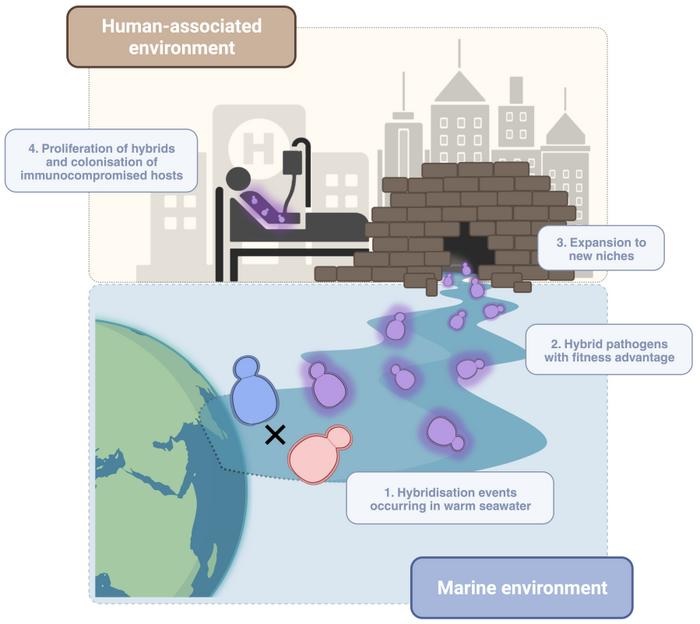The climate emergency poses a significant threat to human health. The increase in temperatures and changes in the conditions of ecosystems, added to globalization and the action of human beings, such as the extensive use of fungicides and antibiotics in agriculture, can favor the appearance and expansion of new species of microorganisms. potentially virulent pathogens, until now ignored, such as fungi.
Knowing what evolutionary routes these potential pathogens have followed, how they have acquired their virulence or how they have developed the ability to infect humans is key to being able to monitor them and prevent future deadly epidemics, such as the recent Covid pandemic, caused by the emergency. of the SARS-CoV-2 virus.
In this sense, a team from the Biomedical Research Institute (IRB Barcelona) and the Barcelona Supercomputing Center - Centro Nacional de Supercomputación (BSC-CNS), led by ICREA researcher Dr. Toni Gabaldón, has identified a fungus of the Candida family, microorganisms that cause diseases such as vaginal candidiasis or systemic candidiasis, which can be fatal in immunocompromised people, as a potential pathogen.
Specifically, they have discovered that Candida orthopsilosis is a hybrid microorganism that originated in a marine environment, from two other parent fungi. And precisely, this hybridization is what has allowed it to acquire properties, such as the ability to infect the human body and its virulence, which make it a potential threat to global health.
The discovery, published in the journal Nature Communications , also opens the door to identifying the adaptations that allow certain microorganisms to be more likely to colonize humans and cause diseases.
"We have been trying for years to answer the question of what makes some species pathogenic for humans and others, like those we have in our microbiome, not," explains Dr. Gabaldón.
"Our results show that hybridization, a process that has until now been little studied, allows us to very quickly obtain qualities that allow us to infect humans. Therefore, in fungi it could be a shortcut to conquer a species like ours," he adds.

Microorganisms in the marine environment are closely related to those found in clinical samples
A cinema infection
In fact, saving the distance, this is the plot of the recent and popular miniseries "The Last of Us" (HBO Max), where a fungus quickly acquires an enormous capacity for infection, transmission and virulence, a perfect cocktail of properties that makes it allows humanity to be decimated in a short time.
Today, it is estimated that there are more than one million species of fungi, most of which are adapted to live in temperate or low temperatures in soil, the aquatic environment, trees and plants, and animals such as amphibians, fish, reptiles and insects. Since the 1980s, the number of emerging infectious disease outbreaks has increased by about 7% per year, and fungi are increasingly being identified as a major threat to global health. And the increase in temperatures has made them tolerant to warm environments, including the human body.
This is the case of Candida auris , a fungus that has adapted to infect people, which is also potentially multi-resistant to drugs and has the ability to spread efficiently in hospital environments. There have already been hundreds of outbreaks around the world, with mortality of 30 to 60%. Scientists point out that it could be the first microorganism that has become a pathogen due to climate change.
Hybrids, better adapted than their ’parents’
The same could happen with C. orthopsilosis. Dr. Gabaldón and his team have studied nine samples of these fungi, isolated in the marine environment, specifically on the coast of Qatar, in the Arabian Sea. Researchers have sequenced and analyzed the genomes and have seen that most of the fungi found are hybrids, which leads researchers to assume that they could have adaptations that give them an advantage over their parents.
Likewise, they have seen that these microorganisms from the marine environment are closely related to those they have found in clinical samples, which is why they point out that the hybridization and emergence of this new microorganism should occur in the sea and from there it went to the health context. . How he did it is still a mystery.
"Our results show us that the genetic characteristics that make hybrids competitive and capable of surviving in the marine ecosystem could be advantageous to do so in humans," says Dr. Gabaldón.
All marine samples in the study were isolated in subtropical waters with temperatures between 35 and 44 degrees. "We saw that the optimal temperature at which C. orthopsilosis strains grow is 35 degrees and that they could survive at much higher temperatures, which is worrying because it overcomes the thermal barrier of mammals that until now had acted as a protective shield and opens the door to colonizing humans," adds Dr. Valentina del Olmo, postdoctoral researcher in Dr. Gabaldón’s group and first author of the study.
Dr. Gabaldón adds that these are opportunistic pathogens that usually infect immunocompromised people, such as patients with cancer, HIV, the elderly, newborns, among others, a group that is increasingly numerous.
"With the continuous increase in global temperatures and the excessive use of antifungal drugs in agriculture and clinic, the appearance of fungi in the environment capable of overcoming the thermal barrier of mammals, acquiring resistance to fungicidal drugs and becoming a potential threat, will increase," the researchers conclude in their study.















